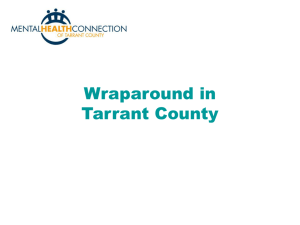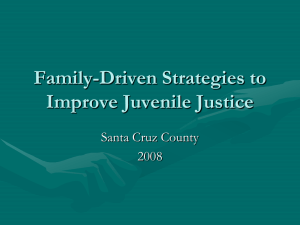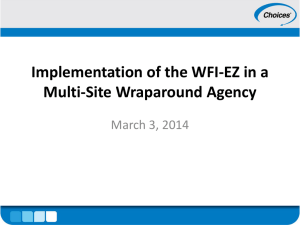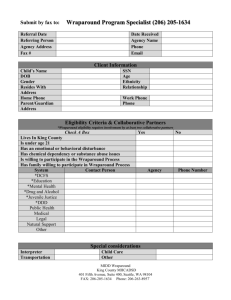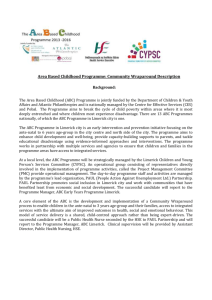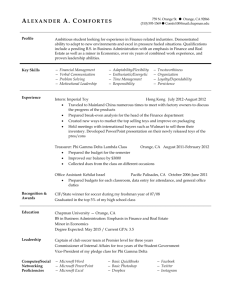Organization of the Strategic Plan
advertisement
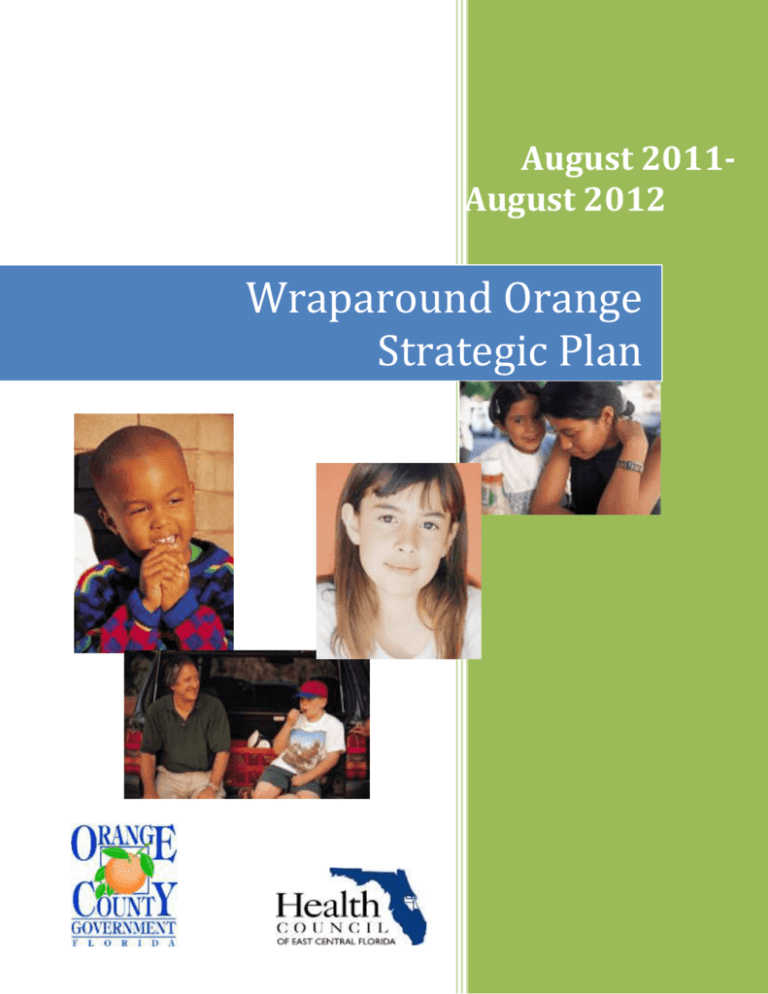
August 2011August 2012 Wraparound Orange Strategic Plan Table of Contents Introduction ..................................................................................................................................... 3 Background and Summary .............................................................................................................. 4 Strategic Direction .......................................................................................................................... 5 Goals ........................................................................................................................................... 5 Organization of the Strategic Plan .................................................................................................. 6 The Five Year Vision of the Wraparound Orange Project ............................................................. 6 Short-Term Goals........................................................................................................................ 6 Long-Term Goals ........................................................................................................................ 6 Underlying Assumptions ................................................................................................................ 8 SWOT Analysis .............................................................................................................................. 8 Strategic Action Plan…………………………………………………………………………….11 Introduction The Health Council of East Central Florida and the Wraparound Orange Management Team completed the development of the initial strategic plan in August, 2010. It provides Wraparound Orange with a roadmap for supports, services and organizational development. The Central Receiving Center Governing Board will review progress quarterly and will review and update the plan annually as needed. Wraparound Orange Committees each share responsibility in the update of goals and activities to continually further project activities. The Wraparound Orange project is funded through a grant by the United States Substance Abuse and Mental Health Services Administration (SAMHSA). This plan was developed with broad involvement and guidance from the Wraparound Orange committee members, notably the Management Team. The Management Team is comprised of approximately 50 members, including service providers, family members, a youth member, private sector members and other vested stakeholders in Wraparound Orange’s activities. This Strategic Plan has been update in August, 2011 to guide the process in upcoming years. Activities that were completed are indicated on the original plan and have been removed. The plan covers August 1, 2011 to August 1, 2012. Background and Summary In October 2009, Orange County Government, Family and Youth Services Division, received $9 million from the Substance Abuse and Mental Health Service Administration (SAMHSA), Children’s Mental Health Initiative, to create “a comprehensive spectrum of mental health and other necessary services which are organized into a coordinated network to meet the multiple and changing needs of children and adolescents with serious emotional disturbances and their families” (Stroul & Friedman, 1986). This system of care, known as Wraparound Orange, is in line with Orange County’s vision of a community characterized by “Empowered and Resilient Children and Families” and its mission in “Providing the Safety Net for Children and Families in Orange County.” Orange County Government worked diligently to educate the community regarding the needed system of care and garner the necessary support of key stakeholders for Wraparound Orange. A coordinated and comprehensive system of care will eliminate duplication of services, increase capacity in the system and provide increased access to needed services. The CRC Governing Board is the responsible entity for working to garner change and create supportive networks within the system of care framework. Under the oversight of the CRC Governing Board, the Wraparound Orange Management Team has been assembled with key stakeholders, representing organizational leadership, family members and project staff. The Management Team serves to provide leadership and support to the system change initiative. The Implementation Team has been assembled from key community stakeholders to support transformation of the system of care. The Implementation Team members were key contributors to the development of the comprehensive strategic plan that focuses on the creation of integrated, cross-agency, culturally and linguistically competent, Family and Youth-driven processes. To facilitate the work of the Implementation Team, various committees and workgroups have been established that include family and youth representation to facilitate system of care transformation. The committees and groups are listed along with a brief description of the responsibilities: Clinical Committee – Manage all of the working groups and provide the overall clinical oversight to the project. o Wraparound Workgroup – Develop and implement the Wraparound Model along with necessary trainings. o Evidenced Based Practice Workgroup – Research and choose a list of evidenced based screening/assessment tools and specific therapeutic practices to be used in the project. o Service Delivery Workgroup – Develop the service delivery model including work flow and policies and procedures. Cultural and Linguistic Competency Committee – Provide oversight to the assessment of the cultural and linguistic competency of community providers and develop a cultural and linguistic competency plan. Evaluation Advisory Board Committee – Oversee all evaluation activities. Family and Youth Voice Committee – Provide feedback and oversight to all other committees and work to establish a family network through the Federation of Families chapter. Finance and Sustainment Committee – Establish a financing plan for both the project and long-term sustainment. Social Marketing Committee – Complete development of the Logic Model and develop the social marketing plan to educate others on the importance of mental health care and the activities of the project. Strategic Direction The strategic direction and goals included in this plan are Wraparound Orange’s response to its understanding of the challenges facing families and youth struggling with severe emotional disturbances, and current opportunities and challenges for changing the ways services are offered in the community. The five-year period of the strategic plan will be a time of assessing and deepening Wraparound Orange’s approaches to its work. Concurrently, Wraparound Orange will take more of a leadership role in working with a broader array of community resources. Goals Over the next five years, the following goals for Wraparound Orange will guide our response to children’s mental health services and support services to the family members in Orange County. These goals provide a roadmap for fulfilling the strategic direction. 1. The community will operate and sustain a family driven and youth guided system of care that meets the needs of each youth and family and includes the continued development and expansion of the Wraparound Orange service delivery system. 2. Youth and families will receive culturally and linguistically competent services within the system of care. 3. The use of evidence-based practices while maintaining high fidelity will be expanded across the community based on the needs of youth and families enrolled in Wraparound. 4. Information and resources will be efficiently utilized and shared. 5. Funding for children’s services will be integrated and allocated based on the individual needs of the youth and families and the system of care framework will be adopted and financially sustained as a community-wide service model. 6. Effective evaluation and continuous quality management will be used to inform decisions and improve the overall system of care and services. 7. The social marketing efforts will raise the community-wide awareness about children’s mental/behavioral health and the system of care values, accessibility, and impact on the community and will reduce the stigma of mental health across the community. Organization of the Strategic Plan As previously noted, this strategic plan is intended to be a management tool for Wraparound Orange. This plan has two purposes. First, it presents the most comprehensive compilation of the plan and its component parts. It is a record of the strategic planning process and the decisions reached by the Central Receiving Center and Management Team. Second, it is a reference guide for strategic planning. At the beginning of each section a box includes a definition of the component part. Vision A community of resilient youth and families well equipped to deal with the stressors of life and enjoy empowered, independent, healthy and productive lives. The Five Year Vision of the Wraparound Orange Project We envision a community where children and families are able to access the services they need, whether they be mental health, scholastic, employment, athletic, and/or physical health in a seamless manner. The ultimate goal is for the youth and families to lead happy lives, utilizing their strengths to achieve stability and personal satisfaction. Short-Term Goals The short-term goals of the Wraparound project unfold through various paths. One such goal is to engage stakeholders, Family and Youth members who demonstrate the desire and commitment necessary to see our vision through to its completion. Another is to develop effective ways to share information and funding within the system of care to begin breaking down barriers among providers, youth, and families. A third short-term goal is to identify the youth and families in most need of help. Long-Term Goals By the sixth year of the grant, 3,500 children (the projected unmet need) will be screened for eligibility and a minimum of 1,000 children will be enrolled and served over the life of the grant. Wraparound Orange intends to serve an average of 200 children each year. It is expected that nearly every child enrolled in the system of care project will be provided with crisis intervention, in-home or community-based counseling and care management as core services, typically needed by children with a serious emotional disturbance. The project will strive to eliminate racial, ethnic, geographic, cultural and socioeconomic disparities in healthcare services by tailoring services to reflect the cultural needs of the families. Wraparound Orange seeks for its youth and families to achieve in each domain of their lives, whether it is at school, the workplace, or their community. The project desires to empower youth and families to exercise their rights to obtain the care and assistance they need in order to be happy and productive citizens. Wraparound Orange plans to position itself so that our efforts will continue long after federal funding has ceased. We want the Wraparound Orange model to serve as the way youth and families get the help they need in Central Florida. Mission Wraparound Orange facilitates a family-driven, youth-guided and culturally competent system of care for those youth with social, emotional and behavioral health challenges and their families. Wraparound Orange is modeled after the System of Care philosophy. A system of care is a coordinated network of community-based services and supports that are organized to meet the challenges of children and youth with serious mental health needs and their families. Families and youth work in partnership with public and private organizations to design mental health services and supports that are effective, that build on the strengths of individuals, and that address each person's cultural and linguistic needs. A system of care supports children, youth and families to higher functioning at home, in school, within the community and throughout life. Values Family Driven, Youth Guided, Culturally and Linguistically Competent, Strengths-based, Individualized, Integrated, Comprehensive, Competent, Respectful, Outcomes based, and Evidenced based. The following core operating values influence the culture and public image of the Wraparound Orange Project as an effective community-based entity serving youth with a Severe Emotional Disturbance and their families. Family Driven – families have the primary decision-making role in the care of their own children and in the policies and procedures for governing care for all children in their community. Youth Guided – Youth have the right to be empowered, educated and given a decisionmaking role in their own care and in the establishment of policies and procedures for governing care for all children in their community. Culturally and Linguistically Competent - Youth and families receive services, supports and interventions designed to meet their specific cultural and linguistic needs. Strengths-based - Youth and their families have all the strengths and resources needed for their own empowerment. A plan for serving them is based on maximizing their strengths, rather than focusing on their weaknesses. Individualized – Youth and families are entitled to receiving the services and supports that build upon their individual strengths and needs while incorporating all of their natural supports. Integrated – Services and Supports are intertwined to achieve maximum benefit. Comprehensive – A wide array of services and supports are available to enhance the natural strengths and resources of youth and their families. Competent – Services are delivered in a highly qualified manner and the system exhibits a very wide range of abilities and knowledge. Respectful – There is a positive feeling of esteem for youth and their families and this is apparent in conduct and in policies and procedures governing care. Outcomes Based – Service delivery is based on the achievement of specific results that can be measured. Evidence – Based - Services that have an empirical foundation for success are used to the greatest extent possible. Underlying Assumptions This is a set of beliefs about what frames Wraparound Orange’s work. Underlying assumptions inform work or why we choose to tackle problems or issues in a certain way. Wraparound Orange believes that: 1. Youth and families are capable of making decisions about what will best meet their needs. 2. Youth and families are resilient and have the strengths necessary to succeed. 3. Fidelity to the Wraparound Model and System of Care values is imperative in achieving our goals. 4. Promoting cultural and linguistic competence best addresses the needs of youth and their families. 5. Service providers are responsive to the unique needs of each Family and Youth. 6. Service providers utilize a family-centered approach. 7. There should be “no wrong door” when accessing services. 8. Education on mental health issues in the community reduces stigma. 9. Evaluation and continuous quality management are critical components in assessing and improving the system of care. 10. Sharing data across providers reduces duplication of efforts and accelerates the provision of service delivery. 11. Financial sustainability is tantamount to the success of our efforts. 12. Finances should not serve as a barrier to service delivery. 13. To obtain efficiency, financial resources should be blended and leveraged. 14. The community must be active in the design, implementation, and evaluation of our efforts. SWOT Analysis The following is a brief summary of strengths, weaknesses, opportunities and threats (SWOT) highlighted by the Wraparound Orange Management Team, committees and family members. The SWOT analysis is intended to orient us in our work plan activities and sensitize us to our underlying assumptions. Strengths are internal characteristics, qualities, and capacities that are doing well and are part of the reason the organization’s accomplishments. Weaknesses are internal qualities that need to be improved. Opportunities refer to external activities or trends that the organization may benefit from, connect with or take advantage of to grow or enhance its performance. Threats are external activities or trends that threaten the current and future success of the organization. Strengths Multiple provider agencies that are currently part of the system Extensive training available across the community Tri-County SEDNET-Multiagency Network for Students with Emotional Disabilities (SEDNET) Multiagency teams currently exist Support from University of Central Florida and its resources Past experience collaborating (successful models such as Primary Care Access Network and the Central Receiving Center) Media/social marketing through Orange County Government/Youth & Family Services Weaknesses Duplication of services Not enough specialty providers/services Complex funding system, under insured families Lack of knowledge of what exists, no coordination of resource information Entry into the system is not coordinated and is confusing Families don’t always feel they receive quality services or do not feel they are a priority within the system Need additional mental health services and supports within the delinquency and dependency systems Opportunities Reduce redundancy Embedding services within the schools and providing services within neighborhoods (e.g., Community School, Evans Project) State and County alignment across systems (e.g., child welfare and juvenile justice) Early identification and intervention Expand cultural competency in service delivery Increase capacity and access, “no wrong door” “Family directed” over just “family involved” Build peer and family network Mental health parity Healthcare reform Threats Bad economy and poor budgets Insurance difficult to navigate, complicated with varying rules and narrow eligibility criteria Changes in State and local leadership Need diagnosis to receive treatment 0-5 years of age early diagnosis is minimal Fear, denial and stigma related to mental health Executive Summary Updates Wraparound Orange is modeled after the System of Care philosophy. A system of care is a coordinated network of community-based services and supports that are organized to meet the challenges of children and youth with serious mental health needs and their families. Families and youth work in partnership with public and private organizations to design mental health services and supports that are effective, that build on the strengths of individuals, and that address each person's cultural and linguistic needs. A system of care helps children, youth and families function better at home, in school, in the community and throughout life. The Strategic Plan Action Plan replaces the original plan with the following: Strategic Plan Action Plan August 2011 to August 2012 Version 2.0 Goal 1: The community will operate and sustain a family driven and youth guided system of care that meets the needs of each youth and family and includes the continued development and expansion of the Wraparound Orange service delivery system. Overall Objective: Continued development, implementation and expansion of a service delivery system for Wraparound Orange that incorporates the Wraparound Delivery model and System of Care principles with expansion across the community. This system will be easy to navigate with a “no wrong door” approach for youth struggling with a severe emotional disturbance and their families. Multiple committees will work in collaboration to develop expansion protocols for wraparound service delivery. The community will see an increase in timely and appropriate services for youth and their families and will see improved clinical outcomes. Strategy 1-1. Complete new contracts for the addition of enough wraparound staff to serve 200 families in year 3. Action Steps Expand the current contracts to add an additional 6 Wraparound Specialist and 4 Family Partners. Who’s Responsible PD, Clinical Director, and Lead Wrap Specialist Due By August 2011 Outcomes Hiring and Training of New staff Develop and post an RFP for the addition of multiple agencies and staff to have the ability to provide services to a total of 200 families in year 3. Provide Mandatory Training to all staff as identified in Wraparound Orange Procedures; Training Plan. PI, PD, Clinical Director and Procurement Committee. October 2011 is posting of RFP and January 2012 is hiring of new staff. Posting of RFP and Hiring of New staff. PD, Contracted Trainer, Evaluation staff and CLC Coordinator. Ongoing All staff meet Annual Training Requirements Provide community members with opportunities to participate in Wraparound and System of Care trainings (case managers, therapists, school personnel, etc.) PD, Contracted Trainer, Evaluation staff and CLC Coordinator. Ongoing Community providers receive training in System of Care and Wraparound. 11 Strategy 1.2 Maintain a Governance structure that supports family and youth voice. Conduct the Wraparound Fidelity Index to assess fidelity to the Wraparound model. Conduct follow-up training with Wraparound staff based on results of the WFI. Ensure that family partners meet eligibility for Florida State Certification as a family peer specialist. Provide the necessary training and service delivery standards to enroll all family partners in the certification process. Update functions, policies, and procedures as needed for the wraparound model’s implementation Continue to enroll youth and families until a minimum of 200 families per year are served. Expand wraparound model and implementation into a broader provider network, with the goal of implementing communitywide. Evaluation Team Quarterly PD, Wraparound supervisors, Clinical Director, Lead Wrap Specialist Clinical Director, Lead Wrap Specialist As needed December 2012 Ensure System of Care competence. Family partners are certified. Clinical Director, Lead Wrap Specialist December 2012 Ensure System of Care competence. Family partners are certified. PD, Clinical Committee, Lead Wrap Specialist Ongoing Policies are changed to reflect the needs of the families & project. Provider network Ongoing 200 youth and families per year are served. All stakeholders Ongoing The Orange County community has adopted System of Care. Action Steps Ensure every committee meeting has a minimum of 2 family members in attendance, with the ultimate goal of 20% of family members. Who’s Responsible Project Staff Due By Ongoing – August 2012 Outcomes 20% of every committee is comprised of family members. 12 Wraparound will be practiced in the community with high-fidelity to the model. High-fidelity use of Wraparound Strategy 1.3 Maintain a local Federation of Families chapter in collaboration with Osceola and Seminole County Conduct one family support group for parents/guardians on a monthly basis. Conduct monthly youth group meetings for the Y.E.S. and Y.E. S.I.T group members Implement a training program for both youth and parents to promote leadership and advocacy skills Family Members (Federation), Lead Family Contact and Youth Coordinator Family Members (Federation), Lead Family Contact and Youth Coordinator Family Members (Federation), Lead Family Contact and Youth Coordinator Ongoing Monthly support group meetings Ongoing Monthly group meetings for youth March 2012 Parents and Youth receive leadership and advocacy training. Action Steps Obtain 501c3 Status Who’s Responsible Lead Family Contacts Due By November 2011 Hire an Executive Director PD and Federation Board November 2011 Outcomes Central Florida has an established Federation chapter The Federation has an Executive Director The Federation has an established Board. Build a solid board of a Federation Board, minimum of 12 members that Executive represent the interests of all Director 3 counties Contribute financial PD, Management Team assistance to the Federation chapter by entering into a contract with CBC Central Florida, the fiscal agent. January 2012 October 2011 The Federation has a budget approved by the board. Conduct monthly Federation of Family Meetings in Orange County. Recruit family members through quarterly outreach events. Federation of Families, PD October 2011 FOF meetings monthly in Orange County. Project staff and Federation Board Ongoing Quarterly outreach events. 13 Conduct Quarterly family Evaluation Team perception studies to assess and obtain ongoing feedback regarding the system. Strategy 1-4. Continued development and expansion of a coordinated and cohesive delivery model with a “no wrong door” approach. Ongoing, 4 times per year, once each quarter Quarterly family surveys Action Steps Establish an Oversight and Advisory Team to develop a model for centralized intake for youth involved in the mental health system. Who’s Responsible PI, Children’s Central Receiving Center Team. Due By August 2011 Outcomes Establish a Team Invite youth and families to attend committee and team meetings. PD and Project staff Ongoing The team is comprised of a minimum of 2-5 family members. Develop and implement a communication network to coordinate referral processes to other service providers. Develop a plan, solve issues and implement community shared system forms (intake assessment and paperwork, Family Care Plan and Release of Information). PI, Children’s Central Receiving Center Team. May 2012 Coordinated referral processes are completed and in use. Implementation Team and Clinical Committee June 2012 Shared Forms are being used by multiple community providers, for one family one plan model. Monitor process through client satisfaction surveys and provider surveys and revise as needed. Evaluation Team Quarterly, beginning October 2012 Satisfaction survey scores are a 7.0 or higher on a 9 point Likert scale. 14 Strategy 1-5. Enhance the service delivery model across the community. Update Memorandum of Agreements (if contracts not in place) that clearly defines roles, responsibilities in system of care and wraparound collaboration. PD and Project staff. January 2012 Updated Memorandum of Agreements with System Partners Action Steps Increase the use of discretionary funding to assist families with needs that are not met, such as transportation, funding for rent, utilities, etc., using a cross-agency, collaborative approach. Design key clinical service delivery; including case management, respite, mentoring, mobile crisis response and crisis hotlines. Provide mental health overlay and support to natural, community resources used by youth and families (summer camp, after-school activities, etc.) for the purpose of keeping youth in the natural environment. Who’s Responsible Management Team, CRC Board Due By Ongoing Outcomes Families have access to discretionary funds in order to meet their needs. Project Director and Staff Ongoing Families have access to the formal services they need. Family and Youth Voice Ongoing Families have access to the informal services they need. Update the processes, procedures, and flow for service delivery to increase access. Clinical Committee Ongoing Procedures are changed to meet the needs of families. 15 Goal 2: Youth and families will receive culturally and linguistically competent services within the system of care. Overall Objective: See Cultural and Linguistic Competency Plan ________________________________________________________________________________________________________________________ Goal 3: The use of Evidenced-Based practices while maintaining high fidelity will be expanded across the community based on the needs of youth and families enrolled in Wraparound Orange. Overall Objective: Families are offered high-quality & effective services validated by empirical research. Strategy 3-1. Expand the use of Evidenced Based Practices in the community. Action Steps Expand the use of the Achenbach assessment to include all of the DJJ diversion programs. Who’s Responsible PI and PD Due By June 2012 Monitor the need for additional evidenced based practices in the community based on the needs of the youth and families enrolled in Wraparound Orange. Recruit additional service providers to meet needs. Clinical Committee and contracted wraparound staff. August 2012 Management Team OngoingAs needed Implement TraumaInformed Care by training all Wraparound contracted staff in the model. Provide the UCF case management certification program participants with a 2 hour overview of SOC and Wraparound. PD and Youth and Family Services Trainers Ongoing, 2 times per year PD Ongoing, 1 time per class 16 Outcomes Youth entering the DJJ system and enrolled in diversion programs will be screened for symptoms of a mental health disorder and given appropriate referrals. Determine the need for additional evidenced based practices in the community. Ensure that families have access to the services they need. All Wraparound staff will be trained in principles of Trauma-Informed Care. All newly certified case managers will know how to access Wraparound Orange services and will be knowledgeable about SOC values. Conduct the Wraparound Fidelity Index to assess fidelity to the Wraparound model. Conduct follow-up training with Wraparound staff based on results of the WFI. Evaluation Team Twice per year PD, Wraparound supervisors, Clinical Director, Lead Wrap Specialist As needed Wraparound will be practiced in the community with high-fidelity to the model. High-fidelity use of Wraparound Goal 4: Information and resources will be efficiently utilized and shared. Overall Objective: The duplication of services, especially the gathering of information will be reduced. Agencies will be able to share pertinent information. The goal of “One Family One Plan” will be accomplished. Strategy 4-1. Implement the use of a shared data management system for community providers in collaboration with CBC of Central Florida Action Steps Establish a Data Mgmt Committee in collaboration with CBC Central Florida. Assess data management systems of current providers. Report findings to management team. Contract with a management information system consultant. Develop and post a procurement bid. Contract with the vendor established by the procurement process. Train contractual partners. Implement the use of the Community-wide Management Information System. Who’s Responsible PI Due By October 2011 Outcomes Established Committee MIS Committee January 2012 Written assessment MIS Committee February 2012 PD February 2012 Mgmt Team approves assessment and plan MIS consultant hired PD and MIS consultant March 2012 RFP posted PD April 2012 Contract Completed MIS vendor MIS vendor June 2012 August 2012 Staff trained MIS implemented 17 Strategy 4-2. Develop capacity for sharing information amongst providers. Action Steps Develop MoU’s amongst service providers for the sharing of information Who’s Responsible MIS committee and Management Team Due By February 2012 Outcomes MoU’s in place. Develop an information sharing plan that is compliant with various accreditation standards as well as HIPPA regulations MIS committee and Management Team March 2012 Information sharing plan is completed. Develop capacity with the community-wide MIS to share data. MIS Vendor and Management Team June 2012 MIS allows sharing of data Develop information sharing protocols MIS committee and Management Team June 2012 Information sharing protocols are approved for use. Begin the sharing of information. Project partners August 2012 Community partners are able to share information. Goal 5: Funding for children’s services will be integrated and allocated based on the individual needs of youth and families and the system of care framework will be adopted and financially sustained as a community-wide service model. Overall Objective: Develop and execute a plan designed obtain the necessary match contributions to continue Wraparound Orange activities after the end of the grant period. Strategy 5-1. Obtain the necessary in-kind and match contributions to support all grant activities. Action Steps Discuss different options for use of in-kind match options with partners and stakeholders. Who’s Responsible PI and PD Due By Ongoing Outcomes Match opportunities are captured. Assist with on-going facilitation of Finance and Sustainability Committee. PI and PD Ongoing Ongoing exchange of information between committees to enhance project outcomes. 18 Strategy 5-2. Develop and implement financial sustainability efforts within the overall financing plan Strategy 5-3. Obtain corporate sponsorship for various initiatives for Wraparound Orange. Report to the CRC Governing Board and the Management Team the status of funds obtained and ongoing needs. PI and PD CRC – 2 times per year Management Team quarterly Solicit feedback and ideas from the Governance Structure. Action Steps Collectively seek and coordinate funding opportunities that address gaps and enhance project activities. Who’s Responsible Mgmt Team, PI Due By Ongoing Outcomes Develop infrastructure for sustainment. Identify funding sources which are temporary and develop plans to replace them with sustainable funding. Apply for local, state or federal grants to enhance service delivery. Mgmt Team, PI, PD Ongoing New sources will be identified. All Ongoing Expand/improve service delivery to enhance community reach. Incorporate utilization and cost evaluations into the project to support decision making and collect/maintain support for the project. Work with the provider network to monitor if their participation in the system of care is financially viable on a long-term basis. Mgmt Team, CRC Governing Board Ongoing Demonstrate Wraparound Orange Fiscal efficiency. Mgmt Team Ongoing Assess Wraparound Orange Sustainability. Action Steps Who’s Responsible Due By Ongoing Outcomes Demonstrated financial sustainment of System of Care. See Social Marketing Plan Strategies 7.1-7.5 19 Strategy 5-4. Advance Medicaid Reform in the state of Florida to expand the array of services for children’s mental health. Action Steps Continue to dialogue with the State Children’s mental health director and Medicaid director at AHCA about System of Care Discuss different options at the local, regional and state level for blending/braiding funds. Collaborate with current grantee communities and prior grantee communities to establish a plan of action for Medicaid reform Collaborate with the Orange County Mayor and her staff about future financial sustainment of the project. Empower the Federation of Families to vocalize/advocate for the inclusion of peer-to-peer support and wraparound in the State Medicaid plan Forge an alliance with other county consumer/family run organizations; NAMI and MHA as part of a reform plan. Establish points of contact with all the Medicaid managed care entities in the county and advocate for the inclusion of a wider array of services. Who’s Responsible PI and Finance Committee Due By Ongoing Outcomes Collaboration with state level PI and Finance Committee Ongoing Plan of action for alternate funding models. PI and Finance Committee Ongoing Legislative platform across the state. PI Ongoing County level support is established. PI, PD, Mgmt Team, Federation of Families Ongoing Families have a voice at all levels of government. PI, PD, Mgmt Team, Federation of Families Ongoing Increased collaboration. PI and Finance Committee January 2012 Increased collaboration. 20 Strategy 5-5. Obtain reinvestment dollars from other systems including the Department of Juvenile Justice, Substance abuse and Mental Health, Child Welfare and Special Education. Create and implement an action plan for policy change. PI and Finance Committee Ongoing Medicaid includes a wider array of services. Monitor reform activities in the legislature and become involved in the discussion when feasible. PI and Finance Committee Ongoing Medicaid includes a wider array of services. Action Steps Identify reinvestment options for monetary savings achieved from other systems. Implement a MoU with DJJ to obtain a portion of dollars diverted from the Juvenile Detention Center as a reinvestment to this project. Who’s Responsible PI and Finance Committee Due By June 2012 Outcomes Money reinvested from JJ to Children’s Mental Health. PI & PD June 2012 Money reinvested from JJ to Children’s Mental Health. Goal 6: Effective Evaluation and continuous quality management will be used to inform decisions and improve the overall system of care and services. Overall Objective: Develop and execute a continuous quality management plan that provides feedback and suggestions to improve services across all spectra of systems of care. Strategy 6-1. Identify and implement continuous quality management plan. Action Steps Research various CQM activities across other System of Care grantees. Who’s Responsible Evaluation Team and Grant staff. Due By March 2012 Outcomes Completed CQM Plan. Identify potential CQM activities. Solicit CQM activities from various teams and committees. Evaluation Team and Grant staff. Evaluation Team and Grant staff. March 2012 Completed CQM Plan. March 2012 Completed CQM Plan. 21 Strategy 6-2. Monitor implementation efforts toward continual improvement. Implement CQM activities. Evaluation Team and Grant staff. April 2012 Completed CQM Plan. Report on CQM activities on quarterly basis. Evaluation Team and Grant staff. Ongoing Completed CQM Plan. Request Technical Assistance as needed. Evaluation Team and Grant staff. Ongoing Completed CQM Plan. Action Steps Continue to Identify process and outcome indicators. Who’s Responsible Evaluation Team and Grant staff. Due By Ongoing Outcomes High fidelity use of EBP’S Develop indicators to measure processes and outcomes. Evaluation Team and Grant staff. Ongoing Address strengths and shortcomings. Collect data (surveys, interviews, focus groups, etc.) Evaluation Team and Grant staff. Ongoing Address strengths and shortcomings. Analyze and report findings to all relevant stakeholders. Evaluation Team and Grant staff. Ongoing Educate stakeholders to make informed decisions. Make changes to improve quality based on results Evaluation Team and Grant staff. Ongoing Utilizing data to adapt system of care to fit family & youth needs. 22 Strategy 6-3. Maintain Evaluation Advisory Board. Strategy 6-4. Conduct demographic study. Strategy 6-5. Conduct longitudinal study. Action Steps Monitor/Review requirements for evaluations based on SAMHSA. Develop outcomes for local evaluation, and follow outcomes guidelines for national evaluation. Expand membership to incorporate additional partners along with family members and youth. Report findings on quarterly basis to SAMHSA, Evaluation Advisory Board, and Management Team. Who’s Responsible HCECF Due By Ongoing HCECF Ongoing HCECF Ongoing HCECF Ongoing Action Steps Meet with wraparound specialists to discuss data collection strategy. Collect data from wraparound specialist via fax and input data. Report findings on quarterly basis to SAMHSA, Evaluation Advisory Board, and Management Team. Who’s Responsible HCECF Due By Ongoing HCECF Ongoing HCECF Ongoing Action Steps Collect, manage, and submit longitudinal data to ICF Macro. Who’s Responsible HCECF Due By Ongoing 23 Outcomes Compliance with the Cooperative Agreements Research requirements. Outcomes Compliance with the Cooperative Agreements Research requirements. Outcomes Compliance with the Cooperative Agreements Research requirements. Strategy 6-6. Conduct Services and Costs study. Strategy 6-7. Conduct Family Perception study. Meet monthly with evaluation staff and family interviewers to troubleshoot and train. Report findings on monthly basis to SAMHSA, Evaluation Advisory Board, and Management Team. Modify data collection process when necessary. HCECF Ongoing HCECF Ongoing HCECF Ongoing Action Steps Consult with evaluation team, ICF Macro, and System of Care sites on best practices for collecting services and costs data. Develop business associate agreements to distribute to participating service providers. Work with evaluation team website host to create a portal to securely upload data to and from participating providers. Who’s Responsible HCECF Due By Year Two HCECF Year Two HCECF October 2011 Action Steps Develop and submit IRB proposal to Florida Department of Juvenile Justice. Collect data in conjunction with longitudinal study families. Who’s Responsible HCECF Due By Year Two HCECF Ongoing 24 Outcomes Compliance with the Cooperative Agreements Research requirements. Outcomes Compliance with the Cooperative Agreements Research requirements. Strategy 6-8. Conduct local evaluations. Meet monthly with evaluation staff and family interviewers to troubleshoot and train. Report findings on monthly basis to SAMHSA, Evaluation Advisory Board, and Management Team. HCECF Ongoing HCECF Ongoing Action Steps Develop outcomes for local evaluation. Solicit input from evaluation advisory board regarding potential local evaluation study topics. Develop local evaluation outlines for years two and three. Who’s Responsible HCECF Due By Year Two HCECF Ongoing HCECF Ongoing Contact WFI representatives for year two local evaluation. HCECF, PD Ongoing Outcomes Compliance with the Cooperative Agreements Research requirements. Goal 7: The social marketing effort will raise the community-wide awareness about children’s mental/behavioral health and the system of care values, accessibility, and impact on the community and will reduce the stigma of mental health across the community. Overall Objective: To develop a series of educational resources that will successfully communicate and educate the community about Wraparound Orange system of care values and services, and engage citizens and stakeholders in supporting services and children’s mental health. Strategy 7-1. Engage families and youth in the messaging and methods for the social marketing campaign. Action Steps Combine Social Marketing and Family and Youth Voice Committees on a quarterly basis to further evaluate and enhance social marketing strategies and messaging. Who’s Responsible Social Marketing, Family and Youth Voice 25 Due By Ongoing Outcomes Committees will consist of 20% of family members by year end. Strategy 7-2. Develop and conduct a social marketing campaign related to the project. Engage family and youth advocacy organizations to partner in messaging development. Disseminate messaging to targeted audiences via website, Facebook, Youtube and Twitter accounts. Responsive service to consumer comments, questions, and concerns will be provided. Evaluate effectiveness of messaging being disseminated to community by consumer feedback. Social Marketing, Family and Youth Voice Ongoing Family and Youth Voice captured in messaging. Social Marketing, Family and Youth Voice Ongoing 200 hits per month, beginning October, 2011. SAMHSA grant staff Ongoing Social Marketing, Family and Youth Voice Quarterly, beginning October 2011. Customer satisfaction scores in this area will be a 7.0 or higher on a 9 point Likert scale. Customer satisfaction scores in this area will be a 7.0 or higher on a 9 point Likert scale. Action Steps Explore possible regional/statewide collaborative marketing efforts. Who’s Responsible Project Director, Liaison Due By Ongoing Identify potential media collaborators. Social Marketing Committee, PD & staff Ongoing Enter into formal agreements/activities with interested media collaborators. Social Marketing Committee, PD & staff Ongoing 26 Outcomes Successful development and integration of educational messaging and publications throughout the state. Successful collaborative efforts with local media resulting in effective media news spots, interstitials and event coverage. Successful collaborative efforts with local media resulting in effective media news spots, interstitials and event coverage. 7-3. Explore effective social marketing techniques. Collaborate with YES and other youth to develop “Say It Loud” YouTube Site containing informative and thought provoking interstitials targeting youth. Develop culturally and linguistically appropriate materials for social marketing campaign. Social Marketing Committee, YES Group February 2012 Mental Health awareness videos posted on social media sites. Social Marketing Committee, PD & staff February 2012 Proper education of SOC and CMH to targeted languages, demographics and cultures. Disseminate messaging via various media & Social Media Outlets. Social Marketing Ongoing Assess whether campaign reached intended target audience via surveys, collected media data and Wraparound Orange referrals (E.g., “How did you hear about us?”). Obtain approval for materials and messaging from appropriate committees and teams. Social Marketing Ongoing Social Marketing Committee, PD & staff Ongoing Successful disbursement & receipt of info through Facebook page, Twitter account, Widget/Gadget Countdown timer and YouTube site. Successful monitoring & collection of all media, electronic and survey info distributed & tracked through SM sites, mailings & viewership data collection. Consistent & Agreed upon messaging throughout respective committees, mgmt & County Officials. Develop materials for Mental Illness Disability Boards to be displayed at OCPS. Social Marketing 10/2011 Effective messaging in school system. Develop a plan to educate the community regarding Wraparound Orange’s System of Care Values Social Marketing Firm and Committee November 2011 SM education plan is completed in various formats (ppoint, etc.) 27 Strategy 7-4. Conduct outreach activities geared toward the various community and targeted stakeholders. Develop a comprehensive social marketing plan to educate the community regarding the stigma surrounding children’s mental health issues and to build supports, donors and volunteers Implement the social marketing plan and education plan utilizing all aspects of media, public relations, promotions, events editorials, public service announcements, community programming, and other identified measures to raise community awareness. Create youth-oriented promotional items. Social Marketing Firm and Committee January 2012 Stigma reduction plan is completed in various formats. Social Marketing Firm & Committee Ongoing Successful campaign strategies resulting in educated and supportive community Social Marketing Committee, PD & staff February 2012 Successful collaboration with YES & elevation of youth voice in community. Conduct meetings with private sector business members for the purpose of engaging in partnerships for future community awareness activities and/or contributions Maintain/Update the Wraparound Orange website. Management Team Beginning October 2011 Successfully obtain financial sustainment for System of Care Social Marketing Committee, PD & staff Quarterly Successful education of community on System of Care and Children’s Mental Health. Action Steps Engage families and youth to identify, develop, and implement effective outreach activities. Who’s Responsible Social Marketing, Family and Youth Voice Due By Ongoing Outcomes Family & Youth participation in outreach engagements & activities. 28 Develop outreach materials. Social Marketing Committee, PD & staff, Implementation Team Social Marketing, Family and Youth Voice Ongoing Create and distribute a monthly newsletter that provides information to reduce stigma, provide CLC information and give updates to families and community partners. Will be distributed via email to the community, posted on website and mailed to families. Social Marketing, Family Youth Voice October 2011 Revamp our current family brochure to allow for insertion of “panels” of information as needed for particular audiences; youth, school personnel, LEO, etc. Social Marketing Committee, PD & staff, Implementation Team January 2012 Utilize emergent media (Facebook, Twitter, etc.). 29 Ongoing Successful education of community and key stakeholders. Successful education of community and more specifically youth & families with emphasis on elevating youth voice. Successful distribution of System of Care information. Diversified messaging for specific audiences.
